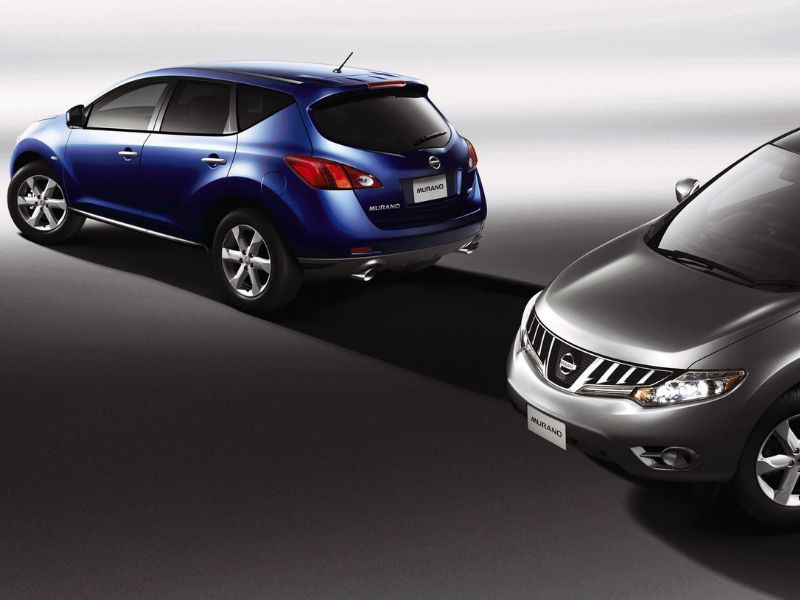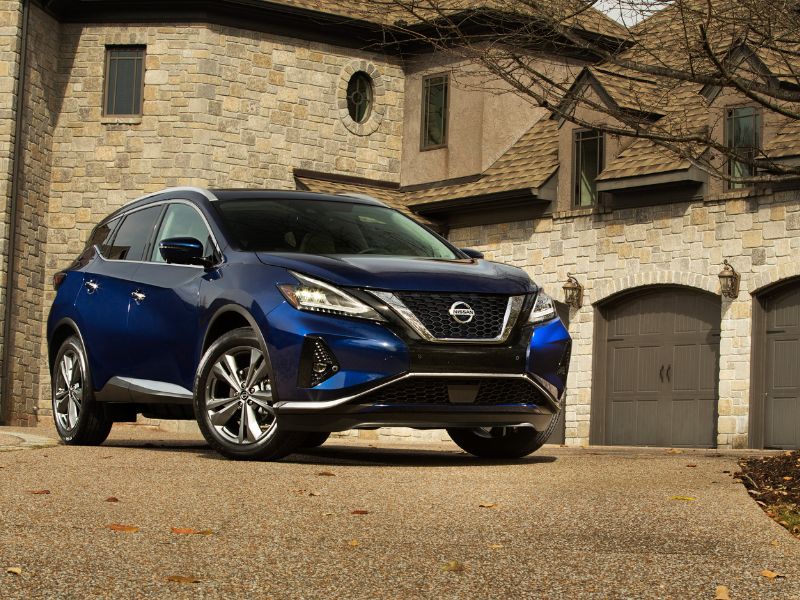If you were considering a Nissan Murano because of its smooth V6 engine and luxurious interior, there are some common issues to consider before taking the plunge.
The Nissan Murano suffers from door handles breaking, sun visors dropping, CVT transmission failures, front seat brackets failing, leaking power steering, and ABS actuator failure.
To help you make a more informed decision, we’ve broken down these issues below and looked at some Murano recalls you need to be aware of (especially if you have one of these models).

6 Main Nissan Murano Problems To Be Aware Of
1. Door Handles Break
Between 2003 and 2004, the owners discovered the exterior door handles of the Nissan Murano to break at around 83,000 miles (133,576 kilometers).
The plastic used got brittle over time and resulted in the door handles of some owners crumbling in their hands while others would stand next to their vehicle with their handles in their hands and no open door.
The price of a new door handle is around $200 at the dealership, while a second-hand part can be sourced much cheaper.
2. Sun Visor Dropping
While it might not be a mechanical failure, a sun visor that drops in front of your eyesight is very dangerous.
At around 79,000 miles (127,138 kilometers) in 2004 and 2005, Murano’s mechanism that holds up the visor has fatigued to a point where it can’t stay up.
The only fix is to buy a new sun visor that costs $200 at the dealership and between $40 to $50 at aftermarket suppliers.
3. CVT Transmission Failure
The CVT transmission on the Nissan Murano was unreliable, with models from 2004 to 2015 affected by CVT transmission failures.
The first signs of the CVT giving up are jerking and hesitation while accelerating, followed by the check engine light and the vehicle going into limp mode.
This can happen anytime, with some owners experiencing it at 17,000 miles (27,359 kilometers) and some even at 98,000 miles (157,716 kilometers).
This is common amongst the Nissans with CVT transmissions since the Nissan Rogue also suffers from it.
4. Front Seat Brackets Failing
From 2005 to 2009, Murano was plagued with the front seat lower brackets breaking, resulting in the seat leaning to the back.
The bracket is part of the seat structure to control the height and the lean of the seat, the material used is fragile and flimsy and breaks over time.
It usually happens at around 76,000 miles (122,310 kilometers), and the dealerships can charge up to $1200 to replace it.
Luckily three is an excellent DIY video on how to replace it yourself.
5. Powersteering Leak
In the 2006 and 2007 model year, Nissan Murano’s high-pressure power steering line was prone to failing.
The failing point is where the line rubs on other components in the engine bay, and road debris can also damage the line.
It is hazardous, especially being the high-pressure line, so the power steering pump can spray the fluid onto an ignition source, and due to the system running out of fluid, it will get harder to steer the vehicle.
The power steering line, since it is the high-pressure side, is the expensive line and will set you back $420.
6. ABS Actuator Failure
The 2009 Nissan Murano owners experienced around 95,000 miles (152,888 kilometers) that their brake pedals would become very soft to the point where some owner’s brake pedals went straight to the floorboard.
The solenoid valves are susceptible to the wrong brake fluid, resulting in the pressure being lost in the system and, thus, the soft brake pedal.
The worst is it can happen with no warning making it very dangerous, and worse of all, a new ABS unit costs around $2,500.
Nissan Murano Recalls
While many Nissan Muranos have been recalled, many out there were not repaired, so consider these problems when buying a second-hand Murano.
If you own a Murano, take your vehicle to a dedicated Nissan dealer to rectify these problems as soon as possible.
2008 Recall
- 2007 to 2009 model-year vehicles, the OCS (Occupant Classification System) module in the passenger seat may need to be revised. They can’t recognize the size of the occupant, resulting in airbags being suppressed and providing worse protection.
2009 Recalls
- 2009 model-year vehicles have incorrect software on the ACU (Air Bag Control Unit) that can cause the passenger airbag to deploy as designed if the car’s battery is very discharged.
- 2003 to 2007 model-year vehicles, the air intake ducts connected to the engine’s air intake system can separate and block airflow, resulting in the engine stalling.
2010 Recall
- 2008 to 2010 model-year vehicles sold in states where salt is used on the roads have to potential of the TPMS (Tire Pressure Monitoring System)transmitter nut that secures the transmitter on the wheels can rust, resulting in an air leak and the tire deflating in a concise time frame.
2012 Recall
- 2012 moel-year vehicles during assembly, the TPMS system might have yet to be activated, resulting in the owners not knowing if the car has a flat tire or defaulting tire.
2015 Recall
- 2015 model-year vehicles’ ABS (Anti-Lock Braking System) actuators can have contaminated solenoid valves, resulting in the valves not being completely close to build-up brake pressure and, thus, worse brake performance.
2016 Recalls
- In 2016 model-year vehicles, the ABS actuator may have a damaged O-ring that results in a lack of brake fluid pressure and worse brake performance.
- 2015 to 2016 model-year vehicles, the OCS (Occupant Classification System) module in the passenger seat may need to be revised; if not repaired, the front airbag may not deploy in the event of a crash.
2017 Recalls
- 2015 to 2017 model-year vehicles, the ABS actuator pumps can start leaking brake fluid onto the internal circuit board resulting in a short and a fire risk.
- 2013 to 2014 model-year vehicles’ power steering hose clamp is not secured and can detach and leak resulting in a fire risk.
2018 Recall
- 2009 model-year vehicles, the ABS unit can react to certain brake fluids that contain corrosion-preventative additives and cause the valves not to close correctly, resulting in worse braking performance.
2019 Recalls
- 2018 to 2019 model-year vehicles, the driver can adjust the rearview camera so there is no image longer visible, and the system will retain the settings, and this fails to comply with the FMVSS (Federal Motor Vehicle Safety Standard).
- 2015 to 2018 model-year vehicles re-recall the ABS actuator pumps can start leaking brake fluid onto the internal circuit board resulting in a short and a fire risk.
2021 Recalls
- 2020 model-year vehicles, the right and left transverse link may be incorrectly manufactured, separating from the balljoint and causing loss of vehicle control.
- In 2020 model-year vehicles, the rear axle housing or front steering knuckle may be incorrectly heat treated, resulting in the components’ insufficient strength resulting in deformation upon impact.

Final Thoughts On Nissan Murano Problems
The Nissan Murano name has been with us for over 18 years, and with age come problems.
The worst is the CVT transmission failures that have been a problem for so long in the Muranos life span.
The best thing to do if you already own a Nissan Murano is to take it to a Nissan dealership and have them check for any recalls that haven’t been completed.
If you are in the market for a used Nissan Murano, get a full vehicle history report and avoid any models with an outstanding recall.
Hopefully, you found this article helpful, and you can go to your next Murano test drive knowing what to look out for.
FAQs
Is the Nissan Murano a reliable car?
Yes, after 2017, Nissan sorted out most of the problems that the previous model year vehicles had.
With a yearly maintenance cost of around $450 compared to the Ford Edge, which is $611, it is also cheaper to maintain than most of its competitors.
What year did the Nissan Murano have transmission problems?
From 2004 to 2015, the Nissan Murano had CVT automatic transmission failures.
It is a costly part of the car that can cost around $4,000, so better try to avoid those model years.
Is a Nissan Murano expensive to repair?
No, with a yearly maintenance cost of just $450 compared to the SUV market average of $850.
Keep in mind that this is focused on Muranos produced after 2017, which are the most reliable model years.
